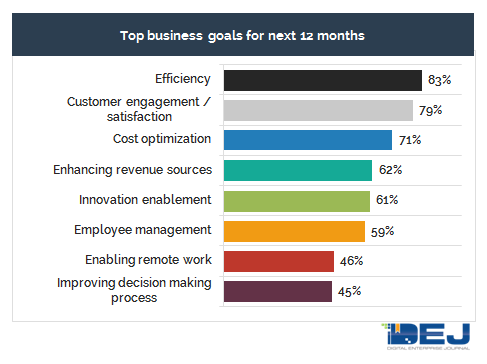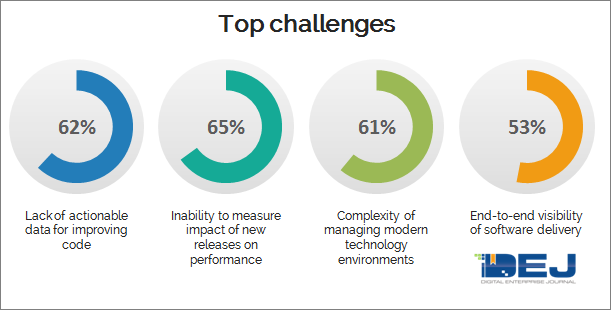IT performance management has a strong impact on key business goals. However, the magnitude of this impact is not necessarily obvious and many organizations are struggling to calculate the true business value of effectively managing IT performance. Addressing this issue is becoming increasingly important, as DEJ’s research shows that connecting technology value to the business outcomes and “translating” the importance of effectively managing IT environments to the language of business is one of the key user requirements.
DEJ’s new study, “The Total Business Impact of IT Performance” identified their eight key goals for the next 12 months. The following sections of this Research Note will analyze key challenges related to IT performance that are impacting organizations’ ability to address each of their eight top business goals.
1 – Efficiency
Lack of efficiency is the top business goal for user organizations, but it has also been one of the key challenges for managing IT performance. As organizations are looking to leverage technology as a driver for business growth, they are realizing that they need to reduce the amount of resources dedicated to maintaining existing IT services and free up more sources for innovation.
Addressing this issue from a technology perspective is becoming more complex. Being more efficient in addressing some of the traditional issues, such as time spent on troubleshooting or root cause analysis, is not getting any easier with the emergence of complex dynamic environments. Additionally, addressing inefficiencies in the process for launching new services is becoming more critical.
IT performance management could have an enormous impact on addressing the #1 business goal that organizations are reporting. However, organizations need to gain more visibility as to how their resources are being used and deploy the right mix of capabilities to eliminate inefficiencies that are causing a major business impact.
$2.465 million – Average Annual Loss due to ineffectiveness in managing microservices
2 – Customer engagement and satisfaction
IT performance management technologies have a major opportunity to help user organizations address this goal. DEJ’s research shows that the majority of organizations are struggling with: 1) having true visibility into the performance of digital services from the customers’ perspective; 2) identifying potential issues before they impact user experience; 3) launching new services based on customer expectations for engagement and experience; and; 4) building resistant and reliable systems so they can continuously deliver digital services at optimal levels of performance.
5.1X – ROI from Taking a Proactive approach for addressing IT performance issues
These are major components of the value proposition of new generation IT performance management solutions and each of these areas has a major impact on business.
However, DEJ’s study, “2020 State of IT Performance Management” shows that, in order to help address this business goal, organizations need to take a customer-centric approach that goes beyond technology and includes organizational culture focused on user experience, processes for bringing IT closer to customers and a knowledge management platform with a customer focus.
3 – Cost optimization
DEJ’s research shows that over the last 18 months non-TPO organizations were 41% more likely to reduce technology cost. However, DEJ’s recent research on “Enabling Top Performing Engineering Teams” reveals that TPOs are much more likely to look for a balance between cost, speed of innovation and user experience. As a result, they experienced a 3.5 times higher increase generated from digital services, as compared to all others.
This shows that there is a major difference between cost reduction and optimization when it comes to technology investments. DEJ’s research shows that it is increasingly important to have data-driven processes to identify cost efficiencies and ensure that technology spend is more predictable.
Creating actionable insights from IT data, context-based automation and autonomous technologies, true visibility into user experience and building reliable and resilient systems are some of the core capabilities for helping organizations enhance their revenue streams.
4- Enhancing revenue resources
Traditionally, the impact of IT performance on revenue was centered around service outages and slowdowns of customer facing applications. However, DEJ’s research study on IT Transformation shows a 3.1 times increase in missed revenue due to slow software delivery since 2016.
In addition to preventing revenue loss due to availability and performance incidents, IT performance solution providers have a major opportunity to reach business executives by proving the value of their technologies around improving time to the market and supporting the creation of new revenue streams.
Creating actionable insights from IT data, context-based automation and autonomous technologies, true visibility into user experience and building reliable and resilient systems are some of the core capabilities for helping organizations enhance their revenue streams.
5 – Innovation enablement
DEJ’s upcoming study, ” Enabling Innovation by Managing IT Performance”, shows that enabling innovation is one of the most multifaceted, while at the same time, one of the most valuable areas of managing IT performance. Addressing this business goal requires organizations to pull together advanced solutions based on different underlining technologies, such as: 1) engineering management platforms; 2) observability solutions; 3) user experience management; 4) SRE, collaboration and knowledge management platforms; 5) debugging and log management solutions; 6) value stream management; 7) monitoring microservices, cloud and serverless, etc.
However, DEJ’s research shows that the importance of this area to the business increased by 27% over the last 18 months. This presents a major opportunity for IT performance management solutions to integrate and work together so that they can address a business area that is well positioned to drive this market forward.
6 – Employee management
DEJ’s research shows that acquiring top talent is one of the key challenges for user organizations. Also, organizations are increasingly understanding that employee engagement and experience is a source of competitive advantage. Therefore, organizations need to put the right mix of capabilities in place to have full visibility into employee experience and productivity.
The importance of effective employee management increases even more when conducting digital transformation projects and deploying new technologies. The ability to have full understanding of how employees are using new technologies (or if they are using them at all) helps business and IT executives properly evaluate the value of their technology investments. Therefore, full visibility into employee experience, coupled with automation, remediation and asset optimization capabilities, are attributes of forward-thinking organizations that are driving a strong value from managing IT performance.
7 – Enabling remote work
$4.218 million – Average annual revenue loss due to lack of capabilities for managing remote work
As more employees are working remotely, organizations are having to deal with a whole new set of business and technology challenges. Also, the range of these challenges is very broad and goes from infrastructure management and visibility into user productivity to ensuring business alignment collaboration and knowledge management. However, DEJ’s research shows that an ineffectiveness in solving these challenges results in a significant business impact and organizations need to keep improving on addressing requirements of enabling remote work.
DEJ’s research shows that, going forward, the majority of organizations will be deploying a hybrid model for their workforce, where some employees will be working from the office, while a growing number of employees will be working remotely. An increased number of remote workers began due to safety issues related to the COVID-19 pandemic, but this trend will not end when the issues surrounding the pandemic are no longer present. Therefore, organizations need to adjust to this new model and deploy capabilities that will allow them to address all of the key challenges of enabling remote work.
8 – Improving the decision making process
This is a business goal that is very well aligned with the key value proposition of modern solutions for managing IT performance. DEJ’s Research Note, “20 Areas Defining IT Performance Management in 2021” shows that “data and creating actionable insights are the key”. Insights driven from IT data can benefit multiple departments and job roles. These insights have a strong impact on improving any decision making process.
DEJ’s study, “17 Areas Shaping the Information Technology Operations Market in 2018” shows that the context of the data is king in this market and that IT performance management is becoming an analytics and data management game. This has a very strong impact on the business as, for many organizations, boundaries between digital and data economy are becoming more blurry.
Additionally, 55% of organizations are reporting that a lack of actionable insights is the key challenge for conducting IT modernization projects, while another 62% are not able to prioritize IT projects. The importance of creating actionable insights is increasing for both business and technology executives and IT performance management technologies are playing a major role in addressing this goal.
Summary
DEJ’s research shows that TPOs are 56% to 2.5x more likely to address the top business goals, as compared to their peers. This shows a clear, strong impact of effectively managing IT performance on key business outcomes.
The ability to connect the value of IT performance management to business outcomes is one of the key requirements for user organizations and it is becoming increasingly important, as the process for evaluating new technology purchases is becoming more business-centric. However, not all IT performance management solutions are created equal. Therefore, organizations should rethink their evaluation processes for technology purchases and ensure that the solutions they select have the strongest impact on the business.




